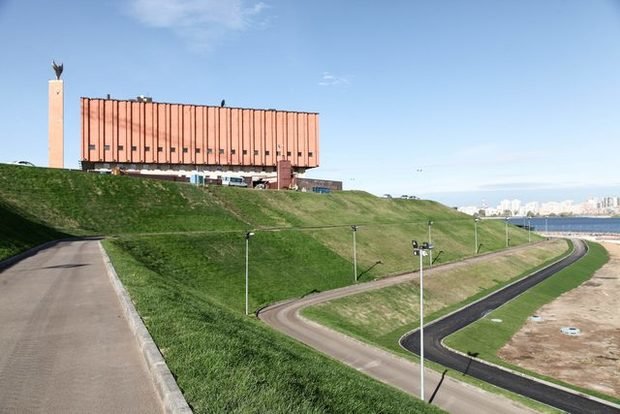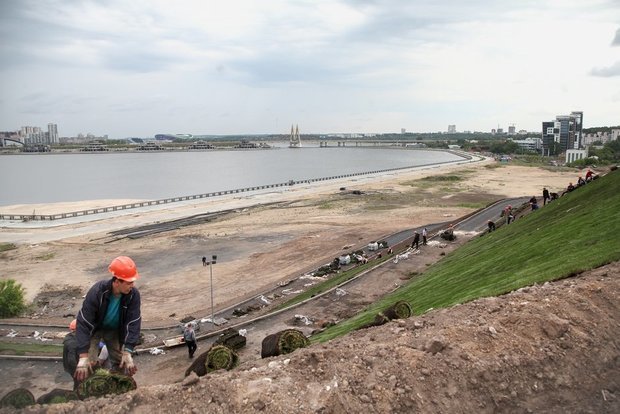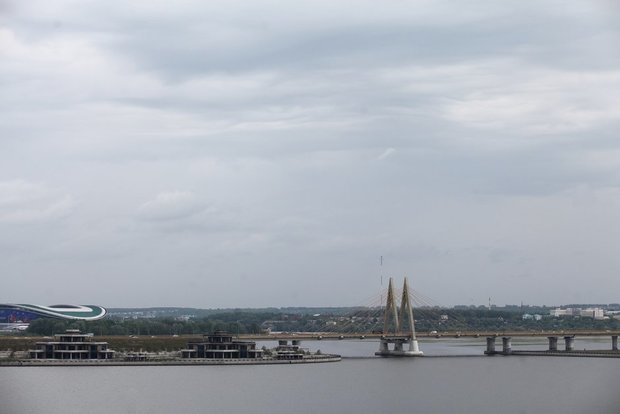New views of Kazan: TAIF renovates the square and hillside near Kazan NCC
What this place was like in different epochs and how it looks today
There are few days left before the opening of the renovated square and the hillside near Kazan National Cultural Centre (Kazan NCC) in the city of Kazan. Very soon, every citizen and guest of the capital of the region will have the opportunity to see how this site has changed. There is fresh grass on the slope instead of thickets of boxelder maple, new asphalt has been laid on the paths, there is an amphitheatre with wooden benches in the walking zone of the square, from where a beautiful panoramic view of the Millennium bridge and the right bank of the Kazanka River can be observed. The landscaping of the site and the slope in front of Kazan NCC was the initiative and a gift of TAIF Group and Tatnefteprovodstroy OJSC to the city. Read about how the transformation of this historical and favourite place of Kazan citizens went in the material of Realnoe Vremya.
People lived on the territory of Kazan NCC already in the early Iron Age
The view of the left bank of the Kazanka River in the old photos of the Soviet period was extremely beautiful and striking by its unusual combination of the building, stylized as a fluttering scarlet banner, and a green hill. This place was the hallmark of the city, depicted on postcards, city holidays were held near it for many years. However, it was known and popular long before the construction of the building of the Kazan national cultural centre.
Historians and native Kazan citizens know the place where the Kazan NCC is located today under the name of Fedorovsky hill. Once on this hill, on the bank of Kazanka River, there stood the Fedorovsky monastery, founded in the early 17th century and existed until 1929. But the history of the slope and the city site in front of the NCC was even more ancient. Fayaz Khuzin, Chief Researcher at the Institute of Archaeology of the Academy of Sciences of Tatarstan, Corresponding Member of the Academy of Sciences, told Realnoe Vremya that the Fedorovsky hill has always been interesting for his instructor — famous archaeologist Alfred Khalikov.
''Near the NCC, Alfred Khasanovich [Khalikov] even looked for traces of ancient Kazan. On the left bank of the Kazanka River during the archaeological works they found the objects made in the early Iron Age. Perhaps, there was a settlement belonging to the Ananyino culture. We are talking about the first millennium BC, or even earlier,'' said Fayaz Khuzin.
How the dominant of the left bank of the Kazanka River — the building of the NCC – was built
In the '80s, the Fedorovsky hill was chosen as the site for the construction of the Lenin memorial. According to the project, the NCC was to become the architectural dominant of the left bank of Kazanka. The cape was prepared for the construction in 1932, when it was planned to build a 300-apartment residential house on it.
''Initially, according to the project of detailed planning of the centre of Kazan of 1974, the public building in this part of the city had to have a circular spiral shape. It was planned that it would become a pronounced dominant of the composition of the new square,'' Associate Professor at Kazan State University of Architecture and Engineering, Deputy Chairman of the Tatarstan branch of the Russian society for the protection of historical and cultural monuments, Honoured Architect of the Republic of Tatarstan Farida Zabirova said.
However, as a result, the project of the Kazan branch of the Central Lenin Museum was based on the work of famous architect Anatoly Polyansky. This model was designed in 1973 to participate in the design competition of the building of the Central Lenin Museum on the site of the pool 'Moscow' in the capital of the USSR. In Moscow, the project of the Lenin Memorial was not implemented and a few years later it was ''redrawn'' for the construction in Kazan.

''In 1982, I attended a meeting of the city planning council, where the project of the future NCC was actively discussed. It was implemented in 1983-1988 and became the last branch of the Central Lenin Museum in the USSR. When designing the building, the author adhered to the idea of ''Lenin — our banner''. The museum was to consist of red-granite inclined prisms, personifying the image of the waving banner,'' says Farida Zabirova.
However, the builders did not appreciate the architect's plan, saying that it would be difficult to implement. Therefore, it was decided to put the prism vertically. As a result, the building lost the intended dynamism, and fluttering banners in its appearance are difficult to see.
About how the meeting place of the citizens became a backwater
As the Lenin memorial, the building did not last long due to the well-known historical events. In 1992, it housed the national cultural centre Kazan, which became a meeting place for cultural figures, regional intelligentsia and the public, celebrations and concerts. The building combines several museums, children's clubs, a concert venue. Over time, the square in front of the NCC, named after Tatar revolutionary Mirsaid Sultan-Galiyev, turned into a meeting place for young people.

At night, cars were parked in the square, loud music was playing, young people smoked hookah and organized car races. Green lawns eventually faded, the grass on the slope grew heterogeneous islands. The left bank of the Kazanka River was overgrown with boxelder maple, footpaths were broken, garbage left by random guests piled up in the bushes, and in the thickets it was often possible to notice a company of people without a certain place of residence. Evening walks along the bank were just unsafe.
The fate of the historic slope was decided in 2018
The fate of the neglected corner was decided last June, when the management of TAIF Group offered President of Tatarstan Rustam Minnikhanov to expand the territory of improvement in front of the NCC to the Fuchs garden. It was a gift of the industrial group of the enterprises to the city, its guests and first of all native Kazan citizens. However, at that moment the proposal did not find support from the Kazan city hall. Only in 2018, thanks to the support of the president of Tatarstan, the project was approved by the city authorities, and the total area of improvement increased to 30,800 square metres.

The paved area of Sultan Galiyev square was diluted with lawn islands, wooden benches and cobblestone paths. Kazan citizens, seeing that the work began, began to apply with proposals for improvement. Many people asked why trees have never been planted near the NCC. Since there is no possibility for the growth of trees in this place, TAIF specialists took this point into account in the improvement project — trees were planted in volumetric tubs. However, in the winter they will be taken in warm rooms.
''On the square in front of the NCC trees cannot be planted in the ground because this area is the roof of the parking lot. The ground part of the parking lot is similar to a layer cake, where the first layer consists of concrete, followed by insulation, insulation, screed and asphalt. At this point, only lawn can be sown there,'' told us Deputy Director General of TAIF PSC for construction and overhaul Ilgiz Latypov.
200 KAMAZ trucks with garbage ''in exchange'' for 600 cars with soil for the slope
The ground area of the parking is divided into two functional areas — parking area and walking area. The ground level of the parking lot is provided for parking cars of the disabled and tour buses. In the walking area, there is an amphitheatre with panoramic views of the Millennium bridge and the right bank of the Kazanka River. Below the amphitheare there is green slope, where the workers were laying rolls of grass during all summer, watering it daily. Over the summer, the asphalt on footpaths crossing the slope was renewed.

After the opening of the park, it has become safe to walk on the left bank of the Kazanka River even at night. On the slope, the workers uprooted all the thickets of boxelder maple, removed the garbage that the bushes hid. When landscaping, more than 200 trucks took debris from the territory, it took 600 KAMAZ trucks with soil to strengthen the slope.

The residents of the city immediately felt the difference of the updated view — after the removal of the fence, Kazan citizens took pictures of the opened picturesque panorama with pleasure. Now everything is ready for the opening of the park and the slope. It is planned that it will be held in the near future with the participation of the president of Tatarstan. Realnoe Vremya will follow the further improvement of this territory.